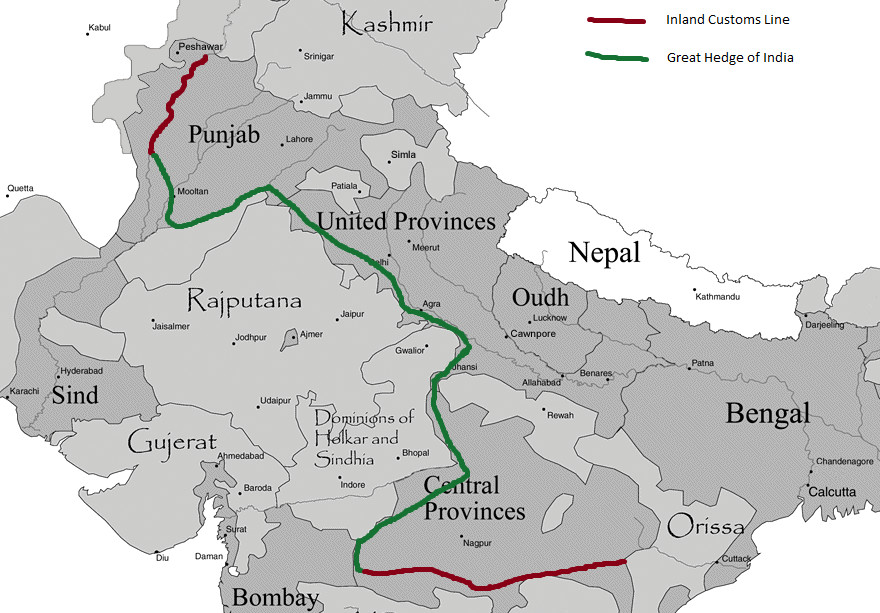265-The Great Hedge of India
Futility Closet
Greg Ross
4.8 • 748 Ratings
🗓️ 16 September 2019
⏱️ 34 minutes
🧾️ Download transcript
Summary

In the 19th century, an enormous hedge ran for more than a thousand miles across India, installed by the British to enforce a tax on salt. Though it took a Herculean effort to build, today it's been almost completely forgotten. In this week's episode of the Futility Closet podcast we'll describe this strange project and reflect on its disappearance from history.
We'll also exonerate a rooster and puzzle over a racing murderer.
Intro:
A group of plasterers working in London’s Tate Britain art gallery in 1897 left a message for future generations.
Four chemical elements were discovered in the same Swedish mine.
Sources for our feature on the Great Hedge of India:
Roy Moxham, The Great Hedge of India: The Search for the Living Barrier that Divided a People, 2001.
Mark Kurlansky, Salt: A World History, 2011.
Sir William Henry Sleeman, Rambles and Recollections of an Indian Official, 1844.
Shugan Chand Aggarwal, The Salt Industry in India, 1976.
Sir John Strachey, India, 1888.
Ajit K. Neogy, The Paramount Power and the Princely States of India, 1858-1881, 1979.
Henry Francis Pelham, Essays, 1911.
G.S. Chhabra, Advanced Study in the History of Modern India: 1813-1919, 1971.
D.A. Barker, "The Taxation of Salt in India," The Economic Review 20 (1910), 165-172.
Nicholas Blomley, "Making Private Property: Enclosure, Common Right and the Work of Hedges," Rural History 18:1 (2007), 1-21.
Barry Lewis, "Village Defenses of the Karnataka Maidan, AD 1600–1800," South Asian Studies 25:1 (2009), 91-111.
Roy Moxham, "Salt Starvation in British India: Consequences of High Salt Taxation in Bengal Presidency, 1765 to 1878," Economic and Political Weekly 36:25 (June 23-29, 2001), 2270-2274.
Roy Moxham, "The Great Hedge of India," in Jantine Schroeder, Radu Botez, and Marine Formentini, Radioactive Waste Management and Constructing Memory for Future Generations: Proceedings of the International Conference and Debate, September 15-17, 2014, Verdun, France, Organisation for Economic Co-Operation and Development, 2015.
"The Great Hedge of India: A Lost Wonder of the World," The Long View, BBC Radio 4, March 14, 2017.
Adrian Higgins, "The Odd Tale of Britain's Wall — a Hedge — Across a Swath of India," Washington Post, Feb. 13, 2019.
David G.W. Birch, "When Britain Built Its Own Wall: The Great Hedge of India," iNews, Feb. 9, 2017.
Stephen Pritchard, "Privets on Parade ..." Guardian, Jan. 14, 2001.
Nilanjana S. Roy, "Of Indian Elections, Onions and Salt," New York Times, Nov. 20, 2013.
Maurice Chittenden, "Great Hedge of India Defended the Empire," Sunday Times, Dec. 10, 2000, 7.
Aneesh Gokhale, "Why British Built the Great Hedge of India," DNA, Aug. 12 2018.
Roy Moxham, "The Great Hedge of India," Sunday Telegraph, Jan. 7, 2001, 4.
Annabelle Quince, "Border Walls Around the World," Rear Vision, ABC Premium News, May 17, 2017.
"Have You Heard of the Salt Hedge?" New Indian Express, March 16, 2015.
Roy Moxham, "Magnificent Obsession," Weekend Australian, Oct. 5, 2002, B.26.
Matthew Wilson, "In the Thicket of It," Financial Times, Nov. 12, 2016, 20.
Moxham writes, "My GPS reading at Pali Ghar was 26° 32.2’ N, 79° 09.2’ E. If this reading is put into Google Earth, the embankment of the Hedge is clearly visible – but only if you already know it is there."
Listener mail:
Jonathan M. Gitlin, "Geeky License Plate Earns Hacker $12,000 in Parking Tickets," Ars Technica, Aug. 13, 2019.
Brian Barrett, "How a 'NULL' License Plate Landed One Hacker in Ticket Hell," Wired, Aug. 13, 2019.
Kim Willsher, "Maurice the Noisy Rooster Can Keep Crowing, Court Rules," Guardian, Sept. 5, 2019.
"French Rooster Maurice Wins Battle Over Noise With Neighbours," BBC News, Sept. 5, 2019.
"If It Quacks Like a Duck: Boisterous Poultry Land French Owner in Court," Agence France-Presse, Sept. 2, 2019.
Tom Whipple, "Larry the Cat Faces Rival as Jack Russell Puppy Arrives in Downing Street," Times, Sept. 2 2019.
Amy Walker, "Downing Street Gets New Resident -- a Dog Named Dilyn," Guardian, Sept. 2, 2019.
Hayley Dixon, "Boris Johnson and Carrie Symonds to Move Rescued Jack Russell Puppy Into Downing Street," Telegraph, Sept. 1, 2019.
"Boris Johnson's New Rescue Puppy Moves Into Downing Street," BBC News, Sept. 2, 2019.
"Dogs That Keep Mice Away," Animal & Pest Control Specialist, Dec. 5, 2013.
"Working History of the Jack Russell Terrier," Jack Russell Terrier Club of America.
Tom Ough, "Sepsis, Incontinence, and Murder Mysteries: A History of Downing Street Pets," Telegraph, Sept. 2, 2019.
Meagan Flynn, "A Lawsuit Against Maurice the Rooster Divided France. Now a Judge Says He Can Crow in Peace," Washington Post, Sept 6, 2019.
This week's lateral thinking puzzle was contributed by listener Dafydd Viney, who sent this corroborating link (warning -- this spoils the puzzle).
You can listen using the player above, download this episode directly, or subscribe on Google Podcasts, on Apple Podcasts, or via the RSS feed at https://futilitycloset.libsyn.com/rss.
Please consider becoming a patron of Futility Closet -- you can choose the amount you want to pledge, and we've set up some rewards to help thank you for your support. You can also make a one-time donation on the Support Us page of the Futility Closet website.
Many thanks to Doug Ross for the music in this episode.
If you have any questions or comments you can reach us at [email protected]. Thanks for listening!
Transcript
Click on a timestamp to play from that location
| 0:00.0 | Welcome to the Futility Closet Podcast, |
| 0:11.9 | forgotten stories from the pages of history. |
| 0:14.6 | Visit us online to sample more than 10,000 quirky curiosities from a plasterer's greeting to a prolific mine. This is episode 265. I'm Greg Ross. |
| 0:25.1 | And I'm Sharon Ross. In the 19th century, an enormous hedge ran for more than a thousand miles |
| 0:31.0 | across India, installed by the British to enforce attacks on salt. Though it took a Herculean |
| 0:36.8 | effort to build, |
| 0:38.0 | today it's been almost completely forgotten. |
| 0:40.8 | In today's show, we'll describe this strange project |
| 0:43.3 | and reflect on its disappearance from history. |
| 0:46.8 | We'll also exonerate a rooster |
| 0:48.5 | and puzzle over a racing murderer. |
| 0:55.9 | And just a quick programming note, we'll be off next week, |
| 0:59.1 | so we'll be back with a new episode on September 30th. |
| 1:03.0 | In late 1995, the author Roy Moxham visited a secondhand bookshop in London |
| 1:08.9 | and bought a book called Rambles and Recollections of |
| 1:11.7 | an Indian official by Major General Sir W. H. Sleeman, K.C.B. Sleeman had traveled through |
| 1:17.7 | Central India in the middle of the 19th century, and his book included a footnote that seemed |
| 1:22.0 | impossible to believe. It was a quotation by a civil servant named Sir John Straiti. |
| 1:28.0 | He wrote, |
| 1:33.2 | A customs line was established which stretched across the whole of India, which in 1869 extended from the Indus to the Mahanadi in Madras, a distance of 2,500 miles, and it was guarded by |
| 1:39.9 | nearly 12,000 men. It would have stretched from London to Constantinople. It consisted, principally, |
| 1:46.1 | of an immense, impenetrable hedge of thorny trees and bushes. This sounds crazy on its face, |
... |
Please login to see the full transcript.
Disclaimer: The podcast and artwork embedded on this page are from Greg Ross, and are the property of its owner and not affiliated with or endorsed by Tapesearch.
Generated transcripts are the property of Greg Ross and are distributed freely under the Fair Use doctrine. Transcripts generated by Tapesearch are not guaranteed to be accurate.
Copyright © Tapesearch 2025.

